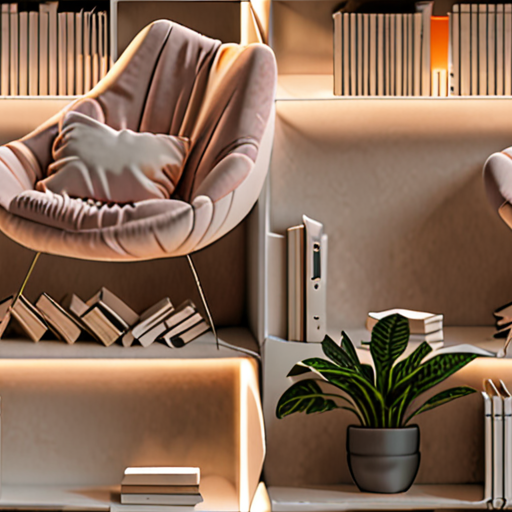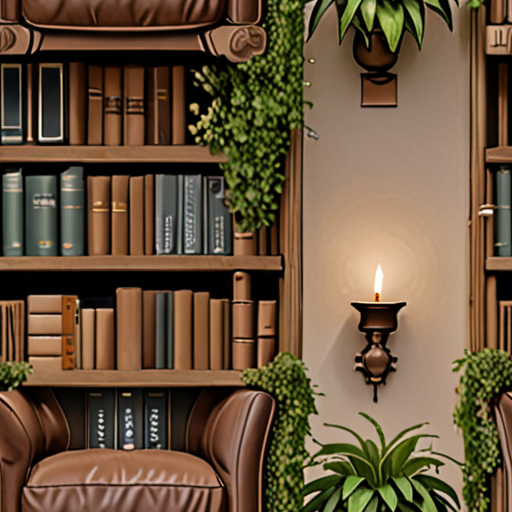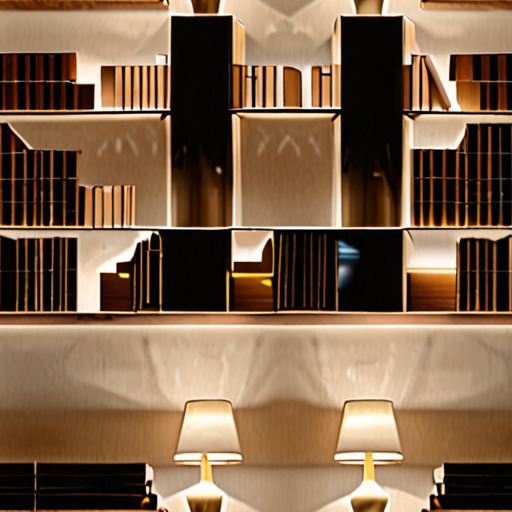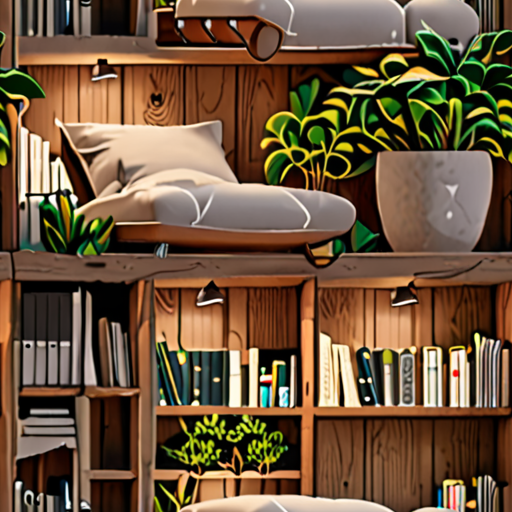For book lovers and avid readers, having a dedicated home library is a dream come true – a serene sanctuary where one can escape into the world of literature, learn new things, and indulge in their favorite pastime. However, setting up a functional and inviting home library setup that suits your reading habits and personal style can be a daunting task, especially if you’re short on space or unsure about where to start.

Creating a Functional and Inviting Home Library Space
As a book lover, I’ve always dreamed of having a cozy and inviting home library space that reflects my reading habits and personal style.
- Assess Your Reading Habits
- Pick a Location
- Select a Color Scheme
- Incorporate Comfortable Seating
- Add Lighting Fixtures
- Display Your Book Collection
- Incorporate Plants
- Consider Storage Options
- Make it Tech-Friendly
- Personalize Your Space
Determine how you want to use your home library space. Do you prefer to read in a quiet corner or surrounded by family members? Do you have a favorite type of chair or lighting fixture?
Choose a spot in your home that receives plenty of natural light and has enough space for your book collection. Consider factors like noise levels, temperature, and accessibility.
Choose a color scheme that reflects your personal style and complements your book collection. Consider warm neutrals like beige or gray, or bold colors like red or blue.
Add comfortable seating options like plush armchairs, ottomans, or a reading nook with pillows and blankets.
Incorporate table lamps, floor lamps, or string lights to create a warm and inviting ambiance.
Showcase your book collection on shelves, bookcases, or display cabinets. Consider adding decorative objects like vases, sculptures, or artwork.
Add plants like ferns, succulents, or flowering plants to bring in a touch of greenery and freshness.
Add storage bins, baskets, or drawers to keep books, magazines, and other items organized and out of sight.
Incorporate technology like e-readers, tablets, or laptops to stay connected and entertained.
Add personal touches like family photos, artwork, or collectibles to make your home library space truly yours.
Design Inspiration
For design inspiration, check out websites like Houzz or Pinterest for ideas and inspiration.
Home Decor Trends
Stay up-to-date with the latest home decor trends by visiting websites like HomeAdvisor or This Old House .
Bookshelf Organization
Learn how to organize your bookshelves effectively by checking out articles on websites like Goodreads or BookRiot .
Lighting Ideas
Discover creative lighting ideas by visiting websites like Lights.com or AllModern .
Designing a Home Library Layout That Maximizes Storage, Comfort, and Visual Appeal
When it comes to creating a home library, there are several essential elements to consider in order to maximize storage, comfort, and visual appeal.
-
Assess Your Space
Determine the size and shape of your available space, taking into account any architectural features or obstacles that may impact your design.
-
Select a Color Scheme
Choose a color scheme that promotes relaxation and focuses the mind, such as soothing blues or calming greens.
-
Incorporate Natural Light
Maximize natural light by placing windows strategically and using sheer curtains or blinds to filter the sun’s rays.
-
Optimize Storage Solutions
Invest in bookshelves, cabinets, and drawers that are specifically designed to store books, documents, and other library materials efficiently.
-
Create a Cozy Reading Nook
Designate a comfortable seating area with plush furniture, soft lighting, and a side table for holding drinks and snacks.
-
Add Decorative Elements
Incorporate decorative elements such as artwork, sculptures, or vases to add visual interest and personality to your library.
-
Consider Ergonomics
Ergonomic considerations such as chair height, desk placement, and lighting levels can greatly impact the comfort and productivity of your library.
-
Integrate Technology
Consider incorporating technology such as e-readers, tablets, or smart speakers to enhance the functionality and convenience of your library.
-
Maintain Clutter-Free Spaces
Establish habits and routines to maintain clutter-free spaces, such as regular tidying and organization sessions.
-
Make it Personal
Infuse your library with personal touches such as family photos, heirlooms, or sentimental objects to create a unique and meaningful space.
By considering these essential elements, you can create a home library that is both functional and aesthetically pleasing, providing a peaceful retreat for reading, learning, and relaxation.

Revive Your Home Library with Creative Repurposing
Give new life to old favorites and discover unique ways to repurpose vintage furniture and materials into a one-of-a-kind, budget-friendly home library setup that reflects your personal style.
-
Upcycle Vintage Doors
Create a stunning bookshelf or display cabinet by repurposing an old door. Add decorative trim, paint, or stain to give it a personalized touch.
-
Transform Old Windows
Turn windows into a beautiful room divider or a unique display case for books and decorative items. Add glass panes or mirrors for extra visual interest.
-
Breathe New Life into Old Furniture
Update an old armchair or sofa by reupholstering it with vibrant fabrics or adding colorful throw pillows. Give it a fresh coat of paint or stain to match your home library’s aesthetic.
-
Get Creative with Lighting
Repurpose old lamps, chandeliers, or sconces to create a warm and inviting ambiance in your home library. Add string lights or fairy lights for a whimsical touch.
-
Make the Most of Bookshelves
Maximize storage space by building custom bookshelves or repurposing old crates and pallets. Add decorative baskets or bins to store books, magazines, and other reading materials.
-
Bring the Outdoors In
Transform an old wooden bench or chair into a cozy reading nook by adding plush cushions and throws. Hang plants or a macrame wall hanging to bring in a touch of nature.
-
Get Crafty with Fabric
Upcycle old fabric scraps into unique book covers, bookmarks, or journal inserts. Use fabric paint or markers to add personalized designs and patterns.
-
Make it Tech-Friendly
Install a smart lighting system or a wireless charging station to keep your devices charged and within reach. Add a state-of-the-art sound system for an immersive reading experience.
-
Emphasize Texture and Pattern
Mix and match different textures and patterns to create a visually appealing and tactile experience. Combine smooth surfaces with rough-hewn wood or woven fibers for added depth.
-
Don’t Forget the Details
Add decorative accents like vases, sculptures, or framed artwork to create a cohesive look. Incorporate scented candles, essential oils, or room sprays to evoke a specific mood or atmosphere.

Choosing the Perfect Location and Layout for a Home Library
When it comes to designing a home library, there are several key considerations to keep in mind in order to balance functionality, aesthetics, and personal enjoyment.
-
Assess Your Space
Determine the size and shape of the area you have available for your home library. Consider the dimensions of the room, the location of windows and doors, and any architectural features that may impact the layout.
-
Define Your Needs
Think about how you plan to use your home library. Will it be a quiet retreat for reading and relaxation, or a hub for family activities and entertainment? Consider the types of furniture and storage you’ll need to accommodate your lifestyle.
-
Consider the Lighting
Lighting can greatly impact the ambiance and functionality of your home library. Natural light is always a bonus, but consider adding table lamps or floor lamps to supplement the lighting and create cozy reading nooks.
-
Choose Comfortable Seating
A comfortable reading chair or sofa is essential for a relaxing home library experience. Consider factors like cushioning, support, and adjustability when selecting seating options.
-
Optimize Storage
A well-designed storage system can help keep your home library organized and clutter-free. Consider bookshelves, cabinets, and drawers to store books, decorative items, and other essentials.
-
Integrate Technology
If you want to make your home library a hub for entertainment and learning, consider incorporating technology like a smart TV, sound system, or e-reader.
-
Make it Personal
A home library is a reflection of your personality and interests. Incorporate personal touches like artwork, collectibles, or sentimental objects to make the space truly special.
-
Balance Functionality and Aesthetics
The key to a successful home library is finding a balance between functionality and aesthetics. Don’t sacrifice comfort and usability for the sake of style, and vice versa.
-
Seek Inspiration
Look to online resources, design magazines, and home decor stores for inspiration and ideas to help you create your dream home library.
By considering these key factors, you can create a home library that is both functional and beautiful – a true sanctuary for reading, relaxation, and enjoyment.
Transforming a Spare Room into a Beautiful and Functional Home Library
As a book lover, I’m always on the lookout for ways to create a cozy and inviting space that showcases my favorite reads.
- Define Your Style
- Select Comfortable Seating
- Organize Your Book Collection
- Add Ambient Lighting
- Incorporate Plants
- Create a Cozy Reading Nook
- Make it Tech-Friendly
- Personalize Your Space
Determine the aesthetic you want to achieve in your home library. Do you prefer a modern and sleek look or a traditional and classic feel? Consider the color palette, furniture, and decor that will reflect your personal taste and reading preferences.
A comfortable reading chair or sofa is essential for a home library. Choose a piece that is plush, supportive, and allows you to relax while reading. Consider adding a few throw pillows and blankets to enhance the coziness factor.
A well-organized book collection is crucial for a functional home library. Use bookshelves, bookcases, or storage units to keep your books tidy and easily accessible. Consider categorizing your books by genre, author, or title to make browsing easier.
Ambient lighting can greatly impact the ambiance of your home library. Install floor lamps, table lamps, or string lights to create a warm and inviting glow. Soft lighting can also help reduce eye strain while reading.
Adding plants to your home library can bring a touch of natural beauty and serenity to the space. Choose low-maintenance plants like succulents or air plants that are easy to care for and won’t distract from your reading experience.
A cozy reading nook is the perfect spot to curl up with a good book. Use a comfortable chair, a side table, and a good reading light to create a relaxing atmosphere. Add a few pillows, blankets, and a good reading lamp to make it the perfect spot to get lost in a story.
A home library isn’t just for books anymore. Consider adding a few tech-friendly features like a tablet stand, a wireless charging pad, or a smart speaker to enhance your reading experience.
A home library is a reflection of your personality and reading preferences. Add personal touches like family photos, artwork, or collectibles to make the space truly yours.
Final Tips
Remember, the key to creating a beautiful and functional home library is to make it your own. Experiment with different layouts, styles, and features until you find a space that feels like a true reflection of your personality and reading habits.
Get Inspired
For more home library ideas and inspiration, check out our blog on Home Ideas Finders .

Optimizing Your Home Library Setup for Relaxation and Productivity
As someone who values both relaxation and productivity, I’m always looking for ways to optimize my home library setup to suit my needs.
- Step 1: Assess Your Space
- Step 2: Choose Comfortable Seating
- Step 3: Optimize Lighting
- Step 4: Incorporate Storage Solutions
- Step 5: Add Plants and Artwork
Determine the purpose of your home library – is it primarily for reading, studying, or relaxing? Knowing this will help you decide on the layout and features you need.
Select furniture that promotes comfort and relaxation, such as plush armchairs or a cozy reading nook. Consider adding pillows, throws, and rugs to enhance the ambiance.
Install dimmable lighting to adjust the brightness according to your mood and activity. Table lamps, floor lamps, or string lights can create a warm and inviting atmosphere.
Invest in bookshelves, storage ottomans, or baskets to keep books, magazines, and other items organized and out of sight. Labeling shelves can also help you quickly find what you need.
Incorporate plants, artwork, or decorative pieces that bring visual interest and serenity to your space. This can help reduce stress and promote relaxation.
Additional Tips:
Consider incorporating a desk or workspace for productivity, and invest in noise-cancelling headphones or a white noise machine to minimize distractions.
Make sure to leave enough space between furniture for easy movement and comfortable navigation.
Conclusion:
By implementing these steps and tips, you can create a home library setup that balances relaxation and productivity, making it the perfect retreat for reading, learning, and unwinding.

0 Comments